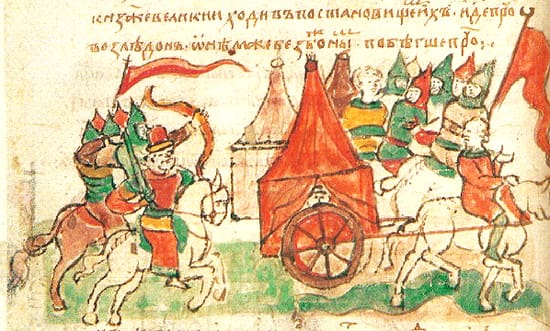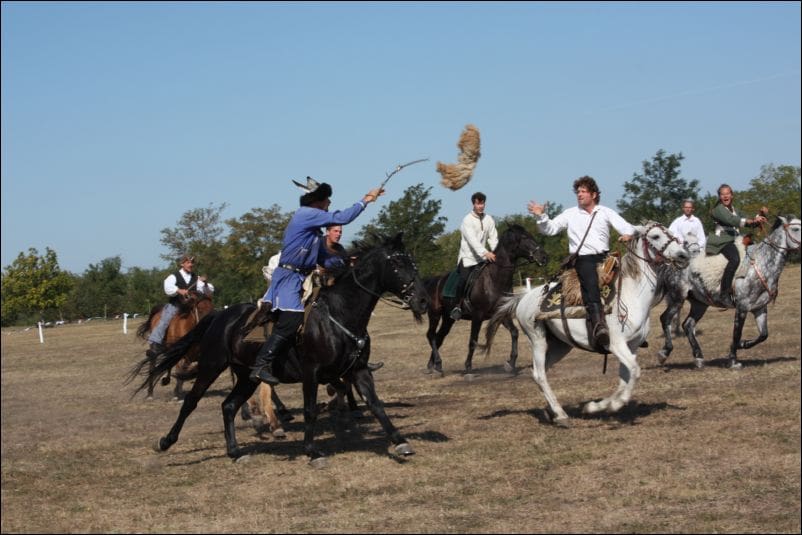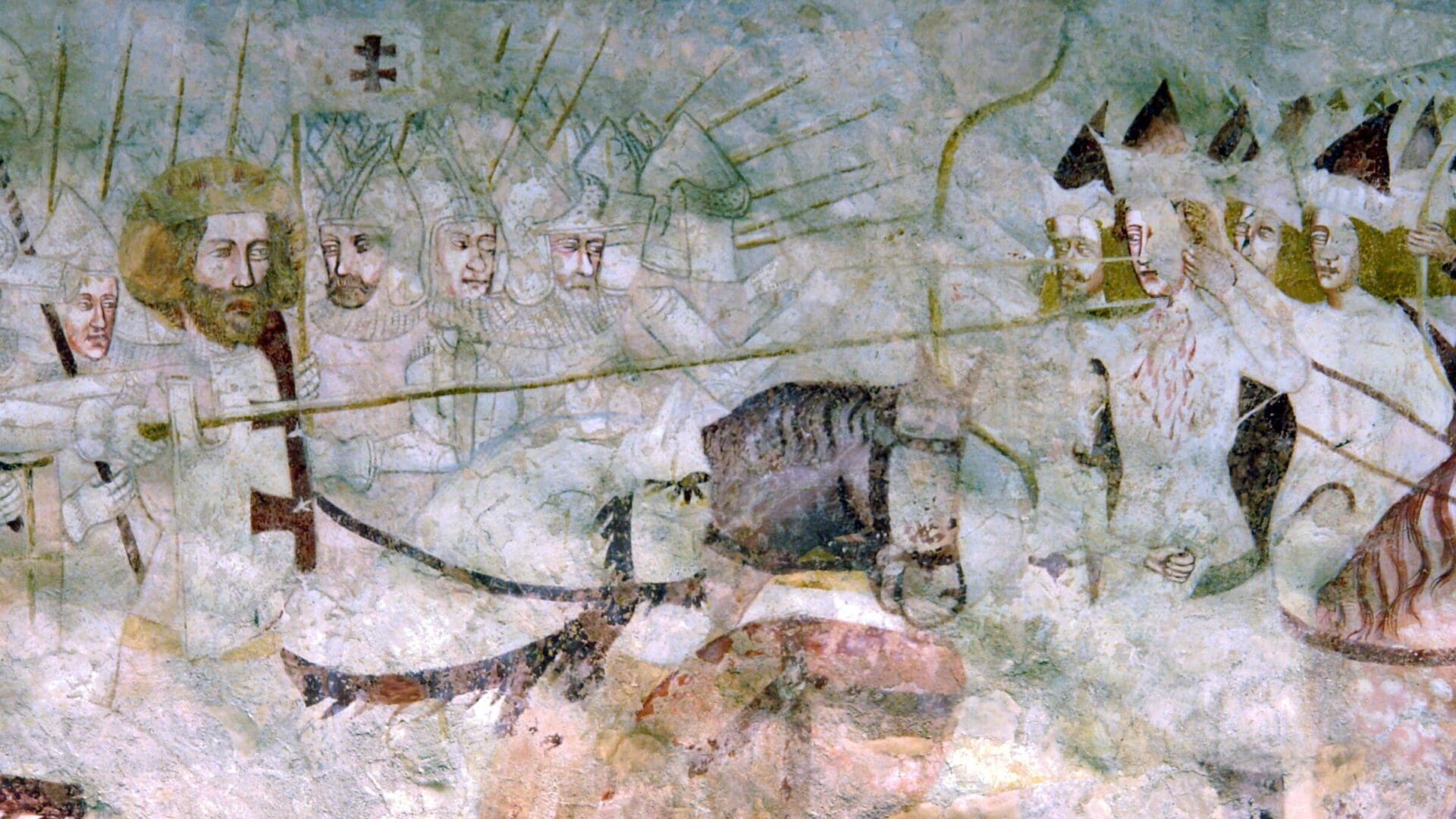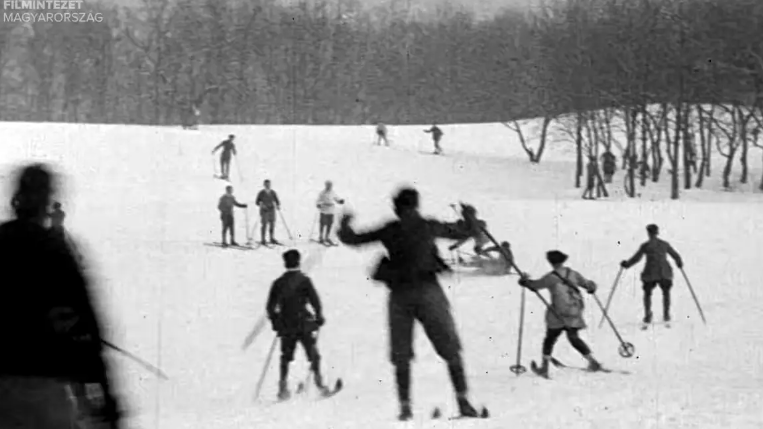The Cuman tribal association (Cuman-Sari-Kipchak tribal association) was the one among the many Turkic-speaking peoples whose fate was the most closely intertwined with the Hungarians. Anonymus, who lived in the 13th century, already names fifteen Cuman persons in his Gesta Hungarorum.[1] That claim is probably a reflection of contemporary beliefs, since according to the findings of archaeology and historiography, the Cumans had not yet appeared on the Eastern European steppe in the 9th and 10th centuries.[2] This does not mean, however, that the Hungarians could not have had a very early relationship with the Cumans. After Árpád’s conquest, Pecheneg tribes lived in the steppes bordering the Carpathian Basin from the east, but as early as around 1054, the Cuman tribes also appeared in warring and alliance relations with the Russian principalities. Around 1070, the Cumans conquered the greater part of the Eastern European steppe, subjugating the Oguz (Oğuz) people living there, who were the ancestors of the Turkic tribes that later took up their new homeland in Anatolia and conquered Byzantium.
It is still disputed to what extent the Cuman-Sari-Kipchak tribal confederation formed a unified state; whether it was, for example, headed by a single, even nominal, khan or khagan, or whether it was a looser conglomerate of steppe tribes and rulers allied with each other. Looking at the results, regardless of the degree of organization of the Cuman state, the tribes pursued a successful policy for at least two centuries, forming one of the outstanding chapters of the great ‘steppe civilization’ (Koppány László Csáji) in the region.
Their leaders were related to the Russian princes through marriages, and their warriors originating from the Cuman confederation—for example, the so-called ‘Mamluks’, originally, converted Muslim soldiers of steppe origin—formed a formidable elite army of light and heavy cavalry.

SOURCE: Wikimedia Commons
A very successful ‘Mamluk dynasty’ came to power in Egypt starting with Sultan Aybek, with the most important Egyptian Mamluk ruler bearing the Cuman/Turkic name Baybars (meaning: ‘Noble/Mighty Panther.’)
The best-known Cuman ruler is Khan Khuten (Kötöny), a ruler who was accepted into the Kingdom of Hungary by Béla IV (and then murdered) just before the Mongol invasion.
But we could also mention Basarab, who ruled in Bessarabia, the present-day Wallachia region, who according to some historians may have been related to the Hunyadi family.[3]
The Cumans were also in close relationship with the medieval Hungarian royal dynasty, as noted in earlier Hungarian Conservative articles, through Elisabeth the Cuman (probably the daughter of a Cuman tribal leader Seyhan) who married into the house of Árpád. Her son, King Ladislaus IV known as Ladislaus the Cuman, was excommunicated by the Pope because of his ‘paganism’ and died young, was not one of the most successful Hungarian rulers, although his position between ‘two worlds’, the world of the Asian steppe, and the world of the West, is more tragic than reprehensible. It also reflects the collective spirit and mindset of the medieval Hungarian people, who had great difficulty integrating into the political-religious structures of the Western world.
Mihály Ferdinandy, one of the most outstanding Hungarian historians of the 20th century, wrote the following about the Cuman-blooded Árpád House ruler, Ladislaus IV of Hungary in his evocative essay:
‘He is the only Árpád ruler who, as a model to be followed, does not choose Saint Stephen or Saint Ladislaus, but the legendary ancestor of his family: Attila. While Béla IV compared the Hun king to the Tatars, László IV already claims to be his successor, and this turning to the East is fraught with deep consequences.’[4]
The language of the Cumans was probably a version of Kipchak, a Turkic language. It has unfortunately become extinct, but based on the examination of the surviving linguistic records, it may have been closely related to today’s Kazakh and Kyrgyz languages.
After the initial struggles and difficulties, the Cumans were integrated deeply into the body of the medieval Kingdom of Hungary, adopting Christianity, but not forgetting the combat tactics and many elements of steppe life.
The ‘Chairs’ (székek) of the Cumans were autonomous administrative units in the medieval Kingdom of Hungary, independent of the royal county system. ‘Chair’, like the chairs of the Saxons and Szeklers, referred to a judge’s chair. The system was created on the basis of the system of older Cuman clans, with the heads of clans becoming captains of the chairs. We are aware of a total of six chairs, such as:
– Halas-szék — in the Kiskunság region, with its centre in Halas (today’s Kiskunhalas)
– Kolbáz-szék — probably presided by the Olás family with Kolbázszállás as its centre in Nagykunság
– Kecskemét-szék — no data available
– Kara-szék — its centre was Karaszállás in the Kiskunság region
– Mizse chair — no data available
– Hantos-szék — its tribal origin is unknown; it was located in the Transdanubian part of Fejér County, probably owned by a Cuman family in the 14th century.[5]
The original religion of the Cumans may have been the same Tengri faith (which could be defined with the typifying term of ‘shamanism’) as that of other Turkic peoples, traces of which survived for a very long time in the Hungarian-Cuman folk culture and tradition. Medieval Cumans tenaciously held onto their ‘paganism’, as church sources indicate the fact that converting the Cumans to Christianity was quite difficult—religion was most closely related to the identity-forming tradition.
Adopting Christianity was indeed a slow and difficult process for the Cuman tribes closely connected to nature and nomadic steppe-life.
Perhaps because the Cult of the Eternal Sky (Tengri) asserts the close relationship of the natural and the supernatural worlds, the religion or cult does not divide the world into ‘material’ and ‘spiritual-supernatural’ dimensions to the same extent as monotheistic religions do. Chosen holy people, that is, the shamans, are able to make contact with this transcendent world, are able to ascend the World Tree to mediate between the gods, divine forces and qualities and the people. According to the belief of steppe people, these shamans exercise a veritably sacred-magical power, manifested trough healings and divinations.
Yet, within a hundred or two hundred years after they settled down, the Cumans gradually lost their connection to nomadic life, and, exactly as the Hungarians had done three centuries earlier, all of them became Christians, and permanently integrated into the body of the Kingdom of Hungary.
On the steppes of Eastern Europe, another steppe power, the Mongol conquest overthrew the rule of the Cumans, starting with the Battle of Kalka. The constituent elements of the tribal confederation were subsequently absorbed into the surrounding peoples and empires, but they did not disappear without a trace, although they did not preserve a ‘visible’ identity.
In Hungary however, a double Cuman-Hungarian identity was formed that still exists to this day.

Therefore, the Cumans, similarly to other steppe peoples like the Avars, Huns, Kabars, or the Jász people (probably Alans), did not ‘disappear.’ Identification with the name of the ruling tribe or people was already characteristic of the organization of the steppe alliances and states during the time of the antique steppe-ruler Mao-tun, who founded the Asian Hun (Xiongnu) empire. This is why the Hun shanyü could later write in his letter to the Chinese emperor: ‘I made the all these peoples Huns, and all the archer peoples were united in one family.’[6] For this reasons, for the Cumans, the continuation and maintenance of this ‘double identity’ could not have been a very difficult task.
As to where the Cumans originally came from, several theories have emerged, but researchers seem to agree that one of the main sources of the components of the tribal confederation could have been the region of Inner Asia bordering China —that is, the region where the Huns are mentioned for the first time in the earliest of Chinese sources.
The great confederation of the Cumans was one of the steppe tribal confederations of Turkic origin, which successfully represented and spread the once mighty ‘steppe civilization’ to a significant part of Eastern Europe. Although the Cuman state was unfortunately destroyed in the power and political dimensions, the descendants of the Cumans still live here among us in Hungary. People with Cuman-Hungarian identity greatly enriched the medieval (and modern) Hungarian nation and strengthened the Eastern relations of Hungarians alongside the also vital Western connections.
[1] Loránd Benkő, Anonymus kunjairól (e-book) https://acta.bibl.u-szeged.hu/65206/1/1995_kelet_es_nyugat_kozott_039-067.pdf, accessed, 17 May 2024.
[2]See Szilvia Kovács, A kunok története a mongol hódításig (e-book) https://terebess.hu/keletkultinfo/kovacs.pdf, accessed 17 May 2024.
[3] That the Hunyadi House came from a Cuman or Rumanian-Cuman family is theoretically possible, since the Romanian principalities initially had an aristorcracy of Cuman origin.
[4] Mihály Ferdinandy, Az Árpád-ház mítoszai, Máriabesnyő-Gödöllő, Attraktor, 2012, 161.
[5] See Gyula Kristó (ed.), Korai magyar történeti lexikon : 9–14. század, Budapest, Akadémiai Kiadó, 1994.
[6] Gyula Németh Gyula (ed.), Attila és hunjai, Budapest, Magyar Szemle Társaság, 1940, 40.







